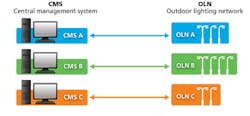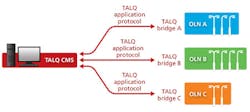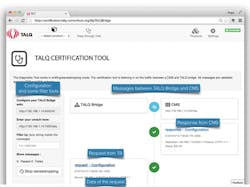GERARD LOKHOFF explains that management of street-lighting control systems based on interoperable standards is the first step toward smarter cities and broader deployment of energy- and money-saving controllable luminaires.
Street-light technology has changed greatly over time, including the type of light sources used, and the way street-lighting systems are operated and managed. Recent concerns about global warming and the rising cost of energy have incentivized utilities and municipalities to deploy new solutions addressing these issues. Intelligent outdoor lighting helps to drastically reduce energy consumption. At the same time, it increases safety and reduces maintenance costs. Together with the deployment of more efficient luminaires based on LEDs, the operators have to think about outdoor lighting networks (OLNs) using a standardized management interface. The TALQ Consortium was created to develop such standards to guarantee interoperability of heterogeneous systems and lower operational and purchasing costs.
Four major trends have influenced the outdoor lighting sector in the past few years. The first trend is the accelerated introduction of LED luminaires in road and urban lighting. LED-based solid-state lighting (SSL) systems, due to their electronic nature, are relatively easy to control. Along with the strong growth of outdoor SSL, a robust increase in the uptake of controllable outdoor lighting is expected.
The second major trend is a worldwide need for lighting control. Adjusting lighting levels depending on activity, presence, traffic, and weather conditions saves energy by providing the right light level at the right time in the right place. Knowing at any time the status of any light point and being able to monitor each of them remotely drastically reduces the number of maintenance trucks on streets and increases safety in the streets.
FIG. 1. The TALQ Consortium standards will be tested and verified in actual installations such as this high-tech campus located in the Netherlands.
The third trend is the professionalization of city operations management to increase overall efficiency. Cities are looking for efficient ways to manage their assets, including lighting. Central outdoor SSL control systems provide the means and tools to reduce operating costs by automatically identifying failures, reducing the number of onsite trips, and enabling remote control - e.g., to adjust the lighting in case of an emergency.
And the last trend, but maybe the most important one, is the global pressure of society to reduce energy consumption and carbon emissions. Today there is a strong need to reduce energy consumption in order to reduce the carbon footprint impact. Moreover, lighting accounts for a large share of energy use globally and street lights operate for extended periods nightly. At present, only a very small fraction of outdoor lighting - likely less than 10% - can be dimmed. Though installation of LED luminaires already provides a significant energy reduction, there is still great potential for further energy savings with controllable outdoor SSL systems.
Transformation to intelligent networks
Based on the trends mentioned here, lighting management is changing in nearly all countries. The operation of traditional lighting systems requires scouting teams to drive during the night to spot failed lights. Paper maps and files are used to manage the maintenance of the lightposts. The light levels cannot be changed; the lighting remains at the same level throughout the night. And in many cases, even the energy consumption of the lighting installation isn't tracked but can only be estimated.
In a modern intelligent outdoor lighting system, it is possible to remotely monitor the lighting network and failures are automatically reported. The system can smartly plan and route the maintenance work to minimize street blockages and maintenance efforts. Smart systems automatically adapt the light levels during low traffic hours to save energy or enhance lighting to improve safety. In addition to all of this, intelligent systems are generally capable of accurate metering of the consumed energy, enabling municipalities to pay for the actual energy used rather than based on a predetermined fixed rate on unmetered lights.
Initially, outdoor SSL vendors each developed their own proprietary propositions to provide these benefits of smart lighting. However, market adoption was slow, mainly due to perceived risks of a municipality being locked in to one vendor. The reluctance on the part of buyers and specifiers convinced the lighting industry to reflect more about standards and interoperability of their systems.
FIG. 2. In the past, central management systems (CMSs) and outdoor lighting networks have generally been vendor specific, creating an interoperability problem.
To address interoperability, the TALQ Consortium was established in 2012 to set a globally accepted standard for management software interfaces that can control and monitor heterogeneous outdoor SSL networks. Since then, membership has grown from six founding members to nearly 30 international companies with global reach. The consortium has made significant progress establishing standards that will support interoperability and is testing and verifying that work (Fig. 1).
Advantages of interoperability
Controllable OLNs are already used in many countries. The systems consist of a server or central management system (CMS) and networks of connected light points (the OLN) that can be controlled by the CMS. As with so many bright new concepts, many manufacturers had seen the opportunity with intelligent systems and developed their own proprietary technologies. Innovative outdoor lighting operators that adopted these new propositions appreciated the benefits but also were confronted with a situation in which an addition from another vendor might necessitate the use of a different CMS (Fig. 2).
Interoperability between systems and system components of different brands would be required to overcome this problem, and the lack of that interoperability led to hesitation in adopting the new systems on the side of the municipalities and utilities. The lack of standardized communication between a CMS and an OLN made systems non-interoperable and therefore difficult to integrate, operate, and maintain. That is why the TALQ Consortium aims at standardizing the interface between the CMS and the OLNs.
With a standard software protocol, it will be possible to connect OLNs of multiple technologies or vendors to a single CMS interface from any vendor (Fig. 3). TALQ focuses only on the higher, so-called application layer of the interface protocol and will neither define the physical layer nor the network layer, which are specific to each OLN. For background on network layers and the Open Systems Interconnect model to which the TALQ work refers, see a feature article on that topic. The TALQ approach is fostering competition, is of benefit to end users, and will help to grow the controllable street-light market.
Central outdoor lighting control
The TALQ Specification enables configuration management, lighting control, and monitoring of outdoor lighting systems. One of the design principles adopted is to leverage existing industry-standard protocols as much as possible in order to focus mainly on the lighting application aspects. As such, the application protocol relies on underlying data transport and network layer services to establish communication between the TALQ interface endpoints.
A variety of data-link- and physical-layer protocols may be used in providing a complete solution. Generally, data-link- and physical-layer protocols are outside the scope of the TALQ Specification, and are left as vendor implementation specific. In other words, the TALQ Specification is independent of the underlying connectivity layers, and TALQ endpoints are able to communicate as long as the necessary transport and network layer services can be established.
The application protocol follows a client-server architecture, in which the CMS is the server that hosts resources and the TALQ Bridge is a client that updates statuses and attributes in the CMS, receives commands and requests from the CMS, and passes them to the OLN for execution of the corresponding actions.
Functionalities and services for smart outdoor lighting
The TALQ Specification adopts a data model in which the system resources and associated functionalities are grouped in functions within a logical device. A TALQ function consists of sets of attributes and events, supporting certain functionalities. For instance, a logical device modeling a luminaire controller may include lighting control-, monitoring-, and metering-related functions.
FIG. 3. TALQ will enable the definition of the management interface for a CMS to interoperate with many different network types.
In general, logical devices can be used to model physical devices that are individually managed within the OLN. Typical logical devices include a luminaire controller, a cabinet controller, an electrical meter, and a communication gateway.
TABLE: The TALQ standard includes mandatory and optional functionality for the CMS and the TALQ Bridge in the OLN.
Vendor specific Not specified in TALQ, format defined | Unique vendor functions and features TALQ gives guidelines for implementation |
Optional Vendor can choose from the optional TALQ functionality | Examples of optional functionality Metering CLO, maintenance factor, scenes... |
Mandatory Basic functionality needed for outdoor lighting operation to be acted upon by every TALQ-compliant OLN/CMS | Base functionalities Discovery and configuration |
In addition to logical devices and functions, the TALQ Specification also defines services that enable operations on the data model to implement well-defined features, such as system configuration, lighting control, data collection, and group management. This data model provides the basis to enable easy adoption by CMS and OLN manufacturers while leaving the model open to accommodate possible future extensions.
FIG. 4. TALQ-compliant products must be verified by a TALQ Test Tool for certification.
Notification and Configuration services are included as basic services required to initialize and configure the system and therefore are mandatory for both CMS and TALQ Bridges. The Lighting Control, On Demand Data Request, and Group Management Services enable the implementation of several remote lighting control and management use cases.
"Especially with these functionalities and services, the TALQ Specification enables cities and users with key features including system configuration, multilevel lighting control, system monitoring, and measurements," emphasized Christophe Orceau, chairman of the steering committee of the TALQ Consortium.
Multilevel control, monitoring, and interoperability
Lighting control is a core capability in a lighting system and it is supported by the Lighting Control Service, which defines the mechanisms to operate the lamp actuator function in order to enable schedule-based and override controls. The override control enables the CMS to actuate any individually connected lamp actuator or groups of lamp actuators.
The TALQ Specification introduces the concepts of a control program and calendar to enable interoperability on the configuration and execution of schedule-based control across diverse systems. Municipalities can define different control programs for different months, or for working days and weekends, and so on. The concept of a control program is very flexible and can combine different trigger events, which may be based on fixed times or dynamic conditions, as well as external inputs.
Remotely monitoring the system's operation conditions through measurements is another key feature. Firstly, measurements of device parameters and performance are supported by measurement attributes. For instance, the lamp monitor function includes a wide range of such attributes to track the device's operation as well as electrical properties, such as supply power, voltage, current, power factor, and others.
Similarly, the electrical meter function may be associated with luminaire controllers, cabinet controllers, or electrical meters installed in switch boxes. The TALQ Specification has defined all electrical meter parameters for both single- as well as three-phase electrical meter applications. In addition to specific device measurements, the application protocol introduces the concept of TALQ events to facilitate system management and diagnosis.
In order to enable interoperability across OLN implementations, the specification defines a set of mandatory features as shown in the table on p. 44. In addition, it enables differentiation through optional and vendor-specific features. Mandatory and optional features (attributes, events, and services) are defined for each endpoint of the application (i.e., TALQ Bridge and CMS). Vendors can make their own selection from the optional functionalities but are also able to add their own unique functionality.
TALQ outlook
The TALQ Consortium has completed its first version of the specification, which defines the application protocol for configuration, management, control, and monitoring of OLNs. First, the consortium defined market requirements based on a complete list of use cases identified by the industry and customers. Next, these were translated into technical requirements. The final specification was compiled from many contributions by member companies with extensive experience and know-how in designing, deploying, and managing OLNs across the globe. As such, it includes a complete set of features necessary to operate and manage OLNs with different architectures, technologies, and capabilities. Widespread adoption of the concepts defined in this document is expected to accelerate the deployment of outdoor SSL control systems.
When deciding on large long-term investments such as OLNs, cities need to be assured even years after the installation that equipment can be exchanged or additions are possible. The TALQ Specification addresses this concern, providing peace of mind to the decision makers.
To ensure the implementations are indeed interoperable, the TALQ Consortium will operate a Certification Program. Before being allowed to carry the TALQ Symbol, implementations will have to be tested using the TALQ Test Tool, a software program that tests either a CMS side or a TALQ Bridge implementation according to a predefined test specification (Fig. 4). After positive evaluation of the test results, a TALQ Certificate can be acquired; the TALQ Consortium will make an up-to-date overview of certified TALQ-compliant products available on its website.
The TALQ certification program is expected to start in the summer of 2015 and the first TALQ-compliant products are expected to be certified by the end of 2015.
GERARD LOKHOFF is Secretary General of the TALQ Consortium (talq-consortium.org).
About TALQ Consortium
Founded in 2012, the TALQ Consortium aims to establish a globally accepted standard for management software interfaces to control and monitor heterogeneous outdoor lighting networks. TALQ is an open consortium for industry members, counting globally nearly 30 member companies. Also stakeholder partners like cities, municipalities, utilities, consultants, and others can participate in a Partner Program to actively build the future of smart outdoor lighting.









